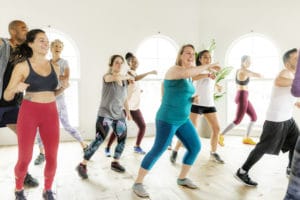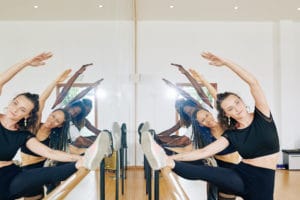Exercise is important for everyone, but it’s not a one-size-fits-all practice. There are countless fun and interesting ways to add physical activity into your routine. If you’re not a fan of the gym or don’t feel like going for a run, maybe it’s time to try a new form of exercise: dance. When done safely, dance can provide a lot of benefits and be an enjoyable way to get in your regular aerobic activity.

“Dance is a great workout,” says James Walters, DC, an American Chiropractic Association (ACA) member whose career as a professional dancer led him to a career in chiropractic. One of the biggest health benefits he sees in dance is that it exercises the whole body. “No matter what you’re doing, every part of your body is generally doing something,” he says.
This kind of whole-body exercise can have a number of physical and mental health benefits. Dance gets your heart pumping, making it a great cardio workout. It can also help with balance and strength, using muscles that might not be activated in other kinds of physical activity. Dr. Walters also recommends dance for the sense of discipline and multitasking ability it instills. “There’s that physical benefit of using your whole body during exercise, and there’s also that mental gymnastics you’re doing,” he says.
First Steps
If you’re interested in getting into dance as a form of exercise, look at dance studios in your area and find a class that’s right for you.
“Anyone can get into dance,” Dr. Walters says. “There’s a lot of studios out there that’ll offer adult dance classes, classes specifically designed with the idea of integrating people who have never taken a dance class before but who want to use it as a form of exercise.”
One of the things that makes dance such an appealing form of exercise is its variety. There are countless styles of dance, as well as other forms of fitness that can go hand in hand with dance classes. “They’ll incorporate things like Pilates, yoga — often it’s a ballet and jazz class, but I’ve even seen adult tap classes,” Dr. Walters says. Though ballet and jazz are probably the most commonly available classes, there are plenty of options out there. Dr. Walters suggests a ballroom dance class for a fun date night, or even a pole dancing or aerial silks class for a new form of exercise. “The world of dance is probably equally as big as the world of sports. There are so many cool things. Find something you like.”
Safety Tips

As with any new physical activity, it’s important to be aware of safety recommendations and the potential for injury if you’re starting dance for the first time. One of the important things to be aware of in dance is positioning. Many dance positions involve moving your body in a way that may not feel natural or comfortable at first.
“If you’re not used to dance and you’re going in and taking a ballet class, it’s really important to hit those basic mechanics,” Dr. Walters explains. “For anyone getting into dance for the first time, I’d tell them to go slow and take it at their own pace.”
Because dance is a whole-body exercise, you’re likely to feel sore after your first dance classes, especially in your hips and knees. These, along with the ankles, are what Dr. Walters considers the most important joints in dancers’ bodies. This also makes them the most vulnerable to injury.
“The single most common injury in all of dance is an ankle sprain,” Dr. Walters says. “A lot of that is because dance happens up on the balls of your feet, and when you’re in that position your ankle’s actually the least stable. When you have a professional dancer who’s been doing this for decades, that ankle is rock-solid. But especially older people getting into dance more as an exercise form, take it slow and really focus on your positioning. Rolling out your ankles is really easy to do when you’re not a master of that technique.”
In addition to sprains, dancers of all levels should be aware of the potential for repetitive use injuries. Dance involves doing many of the same movements over and over, which can cause damage that builds up over time.
“Dancers get the same types of injuries that football players get,” Dr. Walters explains. “The exception is, football players get these injuries because they have people colliding into their body, whereas dancers are doing really tiny microdamage over and over again. Fast forward ten years of their career, all of a sudden they do something they’ve done a million times before and their meniscus tears, or their hip labrum tears.”
Chiropractic and Dance
Whether you have been training for years or just took your first dance class, talk to your chiropractor about how to make sure that dance is a healthy activity for you. “It’s important to have a team of providers that you can rely on for different things,” Dr. Walters says. “Be comfortable with having that relationship of talking to them about what you do and how you do it.”
For more health and wellness information, or to find a chiropractor near you, visit ACA online at www.HandsDownBetter.org.
References
Lindberg S. Benefits of dance: 8 benefits for adults and kids. Healthline. https://www.healthline.com/health/fitness-exercise/benefits-of-dance#benefits-for-kids. 2019 May 10.



